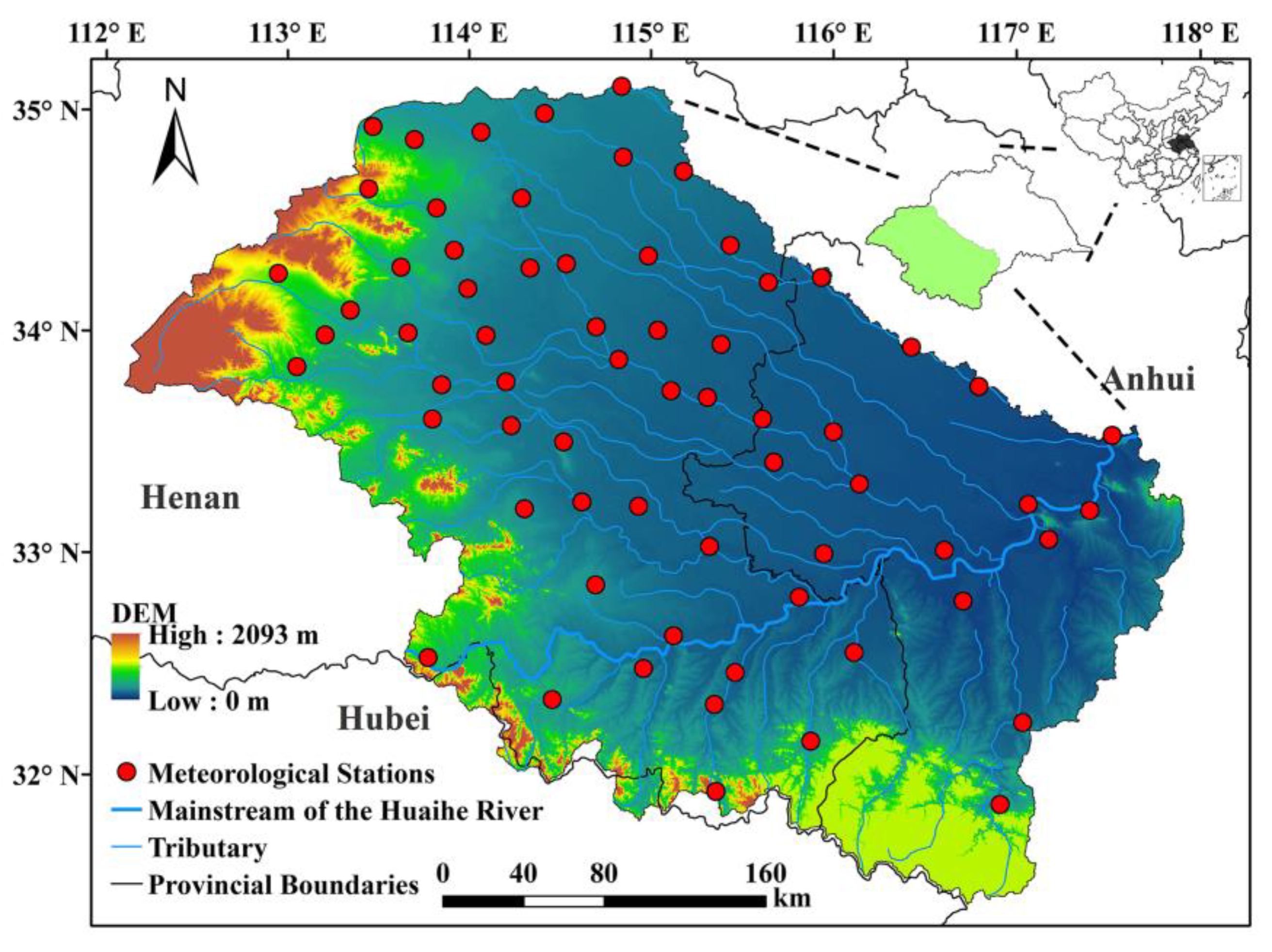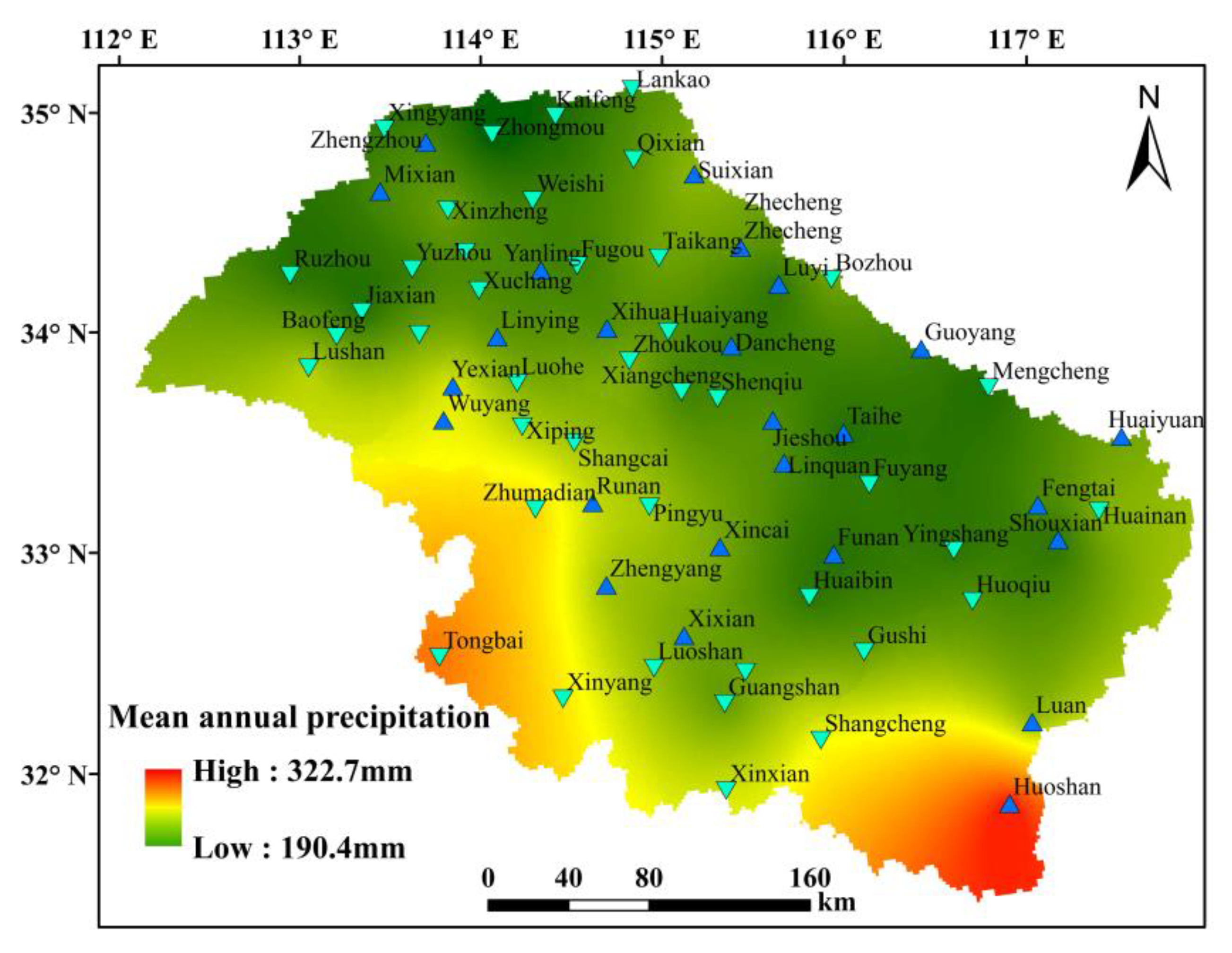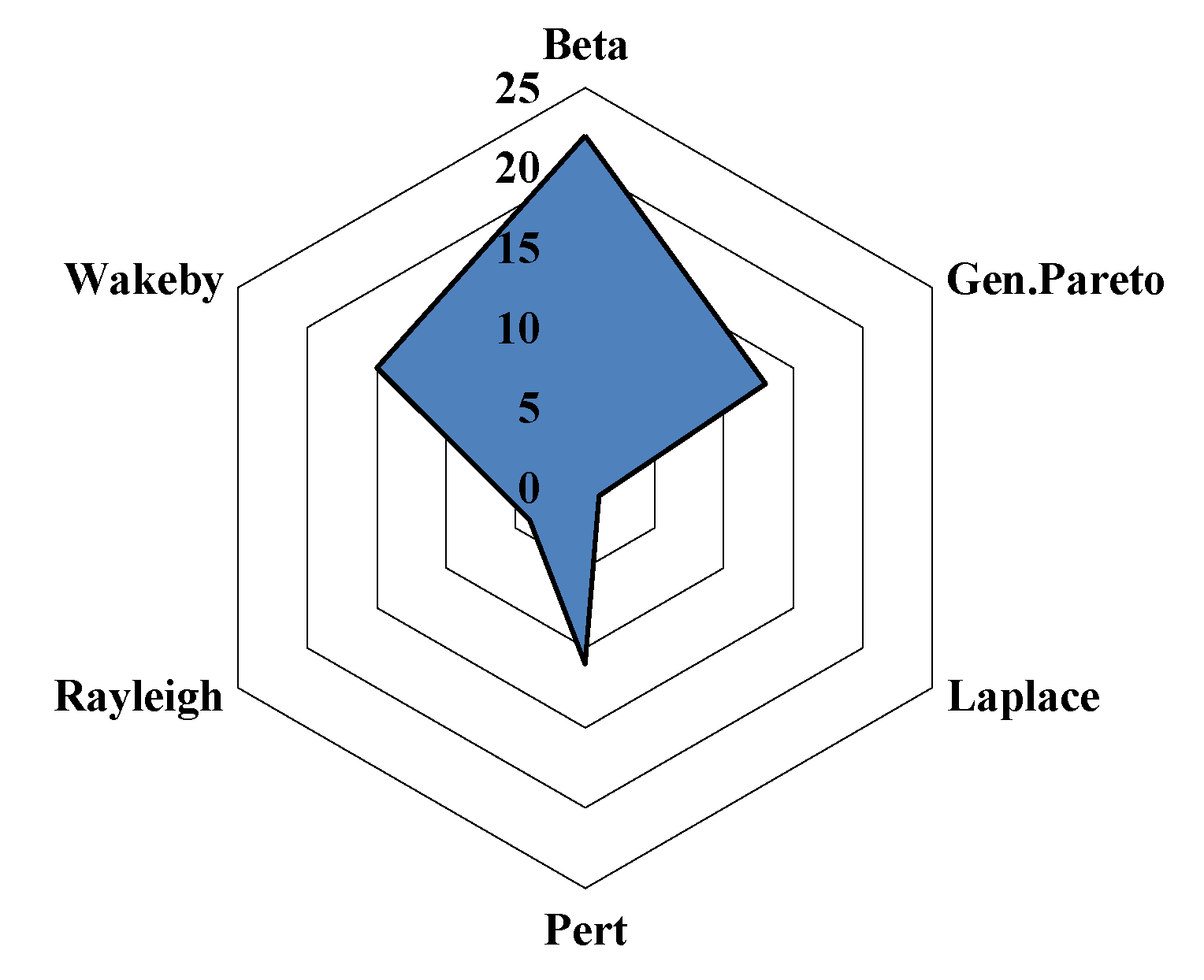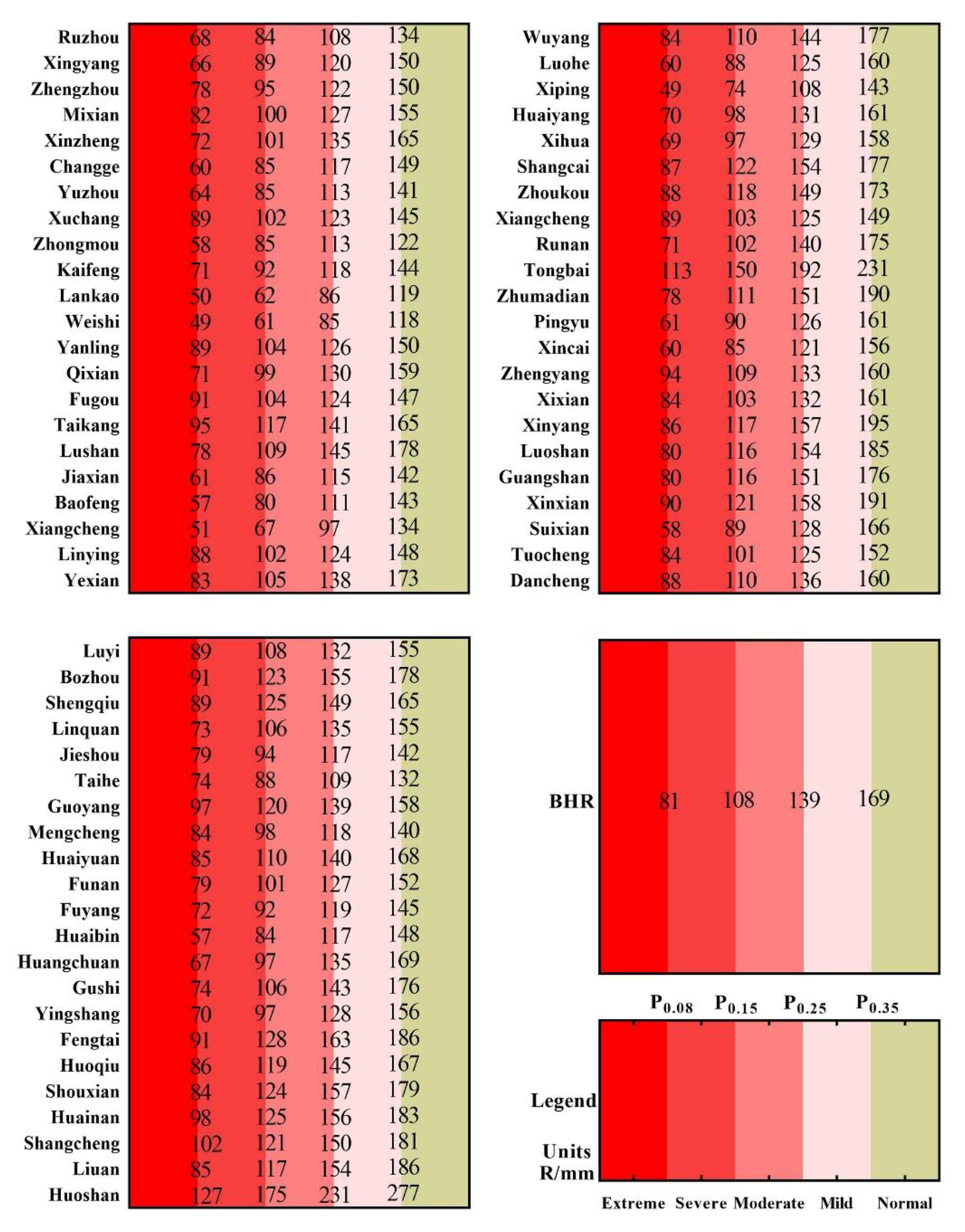Precipitation Thresholds of Drought Disaster for Maize in Areas in Front of Bengbu Sluice, Huaihe River Basin, China
Abstract
:1. Introduction
2. Study Area
3. Data and Methods
3.1. Data
3.2. Methods
3.2.1. Division of Main Growth Period of Maize
3.2.2. Climatic Yield
3.2.3. Water Deficit Index
3.2.4. Calculation of Precipitation Thresholds
3.2.5. Thiessen Polygon
3.2.6. Space Interpolation
4. Results
4.1. Critical Water Period During Summer Maize Growth
4.2. Temporal and Spatial Precipitation Characteristics of Critical Water Period for Summer Maize Growth
4.3. Determining the Optimal Probability Distribution Model
4.4. Determining Precipitation Thresholds of a Drought Disaster for Summer Maize
4.4.1. Numerical Determination of Precipitation Thresholds of a Drought Disaster for Summer Maize
4.4.2. Spatial Distribution of Precipitation Thresholds of a Drought Disaster for Summer Maize
4.5. Validation of Precipitation Thresholds of Drought Disaster for Summer Maize
5. Discussion
6. Conclusions
Author Contributions
Funding
Acknowledgments
Conflicts of Interest
Appendix A
| Year | Actual Disaster Data |
|---|---|
| 1973 | Henan province: About 1.1 million hectares of farmland were influenced, among which 733,300 hectares were seriously influenced in Shangqiu, Zhoukou, and Zhumadian during the first 10 days of August. Approximately 7300 hectares in three counties, Luyi, Dancheng, and Taikang, harvested no grain. Areas in Yongcheng, Tacheng, Minquan, Suixian, and Shangcaixian were seriously influenced by drought, whereas areas along the Huaihe River were slightly influenced. Anhui: In the beginning of August, most areas in Anhui Province had no rain, resulting in drought of different degrees in the whole province. |
| 1985 | Henan: There were no soaking rains in the south in August. The rainfall in Xinyang, the Nanyang Basin, and south of Zhumadian decreased by 60% to 75% from the average level over the past few years, leading to serious summer drought. Dwellers in partly hilly areas experienced difficulties in obtaining drinking water, which had to be transported to 780,000 dwellers and 400,000 draught animals from distant places under the most severe circumstances. The government invested 2100 million RMB to fight drought and natural disasters. |
| 1987 | Henan: About 18,500 dwellers and 3100 hectares of farm crops were hit by drought in Jiaxian, and 2700 hectares of farmland thus turned into a damage area. Approximately 1 million hectares of land were irrigated in the whole province and 3.04 million farmers worked daily. Anhui: It was continuously dry north of Huaibei after the summer drought was followed by autumn drought in quick succession, leading to a situation of high temperature and rapid evaporation. The drought increasingly spread in autumn to south of the Huaibei and Huaihe rivers. |
| 1994 | Henan: Drought developed rapidly due to low precipitation in Henan Province, and no rain fell in late September and early October, leading to high temperatures and more soil evaporation. Most areas were affected by different degrees of drought except Xinyang, in which drought was not obvious. Drought was especially serious north and west of Henan. Most of the soil at 30 cm in Henan contained 10% or less moisture. Anhui: Most parts of the province were hit by drought from September to November. Dry soil layers in Hefei, Huoqiu, and other areas occurred at 7–8 cm, which exerted negative impacts on sowing in autumn. In Linquan, about 1.12 million dwellers were victims of the disaster, with 94,333 hectares turning to damaged land and 8000 hectares having no harvest. |
| 1997 | Henan: The precipitation was nearly zero in the whole province from August 5 and the drought in 65 counties worsened sharply. About 3,084,000 hectares of autumn harvested crops were hit by drought, with 1,618,000 hectares seriously affected and 521,300 hectares of crops failing by the end of August. Rainfall in Luohe was only 2.6 mm over 37 days, leading to reduction in output of 55,000 hectares, and the economic loss triggered by drought was 25.25 million RMB. Anhui: The whole province experienced autumn drought from September to November. 70 counties turned to main drought areas from west of the Huaihe River to east of the Yangtze River. About 2,267,000 hectares of the main output area of summer harvested crops was seriously affected by drought. |
| 1999 | Henan: From 8 July to 3 September, Luohe was hit by summer drought and continuous autumn drought that has rarely been recorded in history. Soil moisture content was only 9%. The soil water shortage and farmland drought were serious; over 146,000 dwellers were affected, 9780 hectares of farmland became damaged, and 2030 hectares failed. Anhui: North of Hefei was hit by summer and autumn drought from June to September. Rainfall in the north was continuously low, leading to a sharply developed drought and rice land cracking from June to September. By 18 August, 1,333,000 hectares of farmland had been damaged, leading to 800,000 hectares of farmland becoming a disaster area. Some 380,000 dwellers had difficulties in obtaining drinking water and the direct economic loss was 2.9 billion RMB. |
References
- Guan, Y.H.; Zheng, F.L.; Zhang, P.; Qin, C. Spatial and temporal changes of meteorological disasters in China during 1950–2013. Nat. Hazards 2015, 75, 2607–2623. [Google Scholar] [CrossRef]
- Esfahanian, E.; Nejadhashemi, A.P.; Abouali, M.; Adhikari, U.; Zhang, Z.; Daneshvar, F.; Herman, M.R. Development and evaluation of a comprehensive drought index. J. Environ. Manag. 2017, 185, 31–43. [Google Scholar] [CrossRef] [PubMed]
- Wang, R.N.; Peng, W.Q.; Liu, X.B.; Wu, W.Q.; Chen, X.K.; Zhang, S.J. Responses of Water Level in China’s Largest Freshwater Lake to the Meteorological Drought Index (SPEI) in the Past Five Decades. Water 2018, 10, 137. [Google Scholar] [CrossRef]
- Leng, G.Y.; Tang, Q.H.; Rayburg, S. Climate change impacts on meteorological, agricultural and hydrological droughts in China. Glob. Planet. Chang. 2015, 126, 23–34. [Google Scholar] [CrossRef] [Green Version]
- Li, F.P.; Wang, Z.T.; Chao, N.F.; Song, Q.Y. Assessing the Influence of the Three Gorges Dam on Hydrological Drought Using GRACE Data. Water 2018, 10, 669. [Google Scholar] [CrossRef]
- Botai, C.M.; Botai, J.O.; de Wit, J.P.; Ncongwane, K.P.; Adeola, A.M. Drought Characteristics over the Western Cape Province, South Africa. Water 2017, 9, 876. [Google Scholar] [CrossRef]
- Zheng, P.N.; Li, Z.Q.; Bai, Z.P.; Wan, L.; Li, X.T. Influence of climate change to drought and flood. Disaster Adv. 2012, 5, 1331–1334. [Google Scholar]
- Du, X.D.; Jin, X.B.; Yang, X.L.; Yang, X.H.; Xiang, X.M.; Zhou, Y.K. Spatial-temporal pattern changes of main agriculture natural disasters in China during 1990–2011. J. Geogr. Sci. 2015, 25, 387–398. [Google Scholar] [CrossRef]
- Hao, Z.C.; Singh, V.P. Drought characterization from a multivariate perspective: A review. J. Hydrol. 2015, 527, 668–678. [Google Scholar] [CrossRef]
- Liu, X.F.; Zhu, X.F.; Pan, Y.Z.; Li, S.S.; Liu, Y.X.; Ma, Y.Q. Agricultural drought monitoring: Progress, challenges, and prospects. J. Geogr. Sci. 2016, 26, 750–767. [Google Scholar] [CrossRef]
- Zhou, L.; Xu, J.G.; Cai, B.M.; Jiang, J.L.; Sun, D.Q. The spatio-temporal changes of grain production and fertilizer consumption and its impact on water environment in the Huaihe River basin. J. Nat. Resour. 2015, 29, 1053–1064. (In Chinese) [Google Scholar]
- Zhang, J.J.; Wang, X.D. Spatial-temporal analysis of the water surplus deficit index for the summer corn’s key period in the Huaihe basin. Chin. Agric. Sci. B 2014, 30, 100–105. (In Chinese) [Google Scholar]
- Gao, C.; Zhang, Z.T.; Zhai, J.Q.; Yao, M.T. Research on meteorological thresholds of drought and flood disaster: A case study in the Huai River basin, China. Stoch. Environ. Res. Risk A 2015, 29, 157–167. [Google Scholar] [CrossRef]
- Mcquigg, J. A simple index of drought conditions. Weatherwise 1954, 7, 64–67. [Google Scholar] [CrossRef]
- Seiler, R.A.; Hayes, M.; Bressan, L. Using the standardized precipitation index for flood risk monitoring. Int. J. Climatol. 2002, 22, 1365–1376. [Google Scholar] [CrossRef] [Green Version]
- Livada, I.; Assimakopoulos, V.D. Spatial and temporal analysis of drought in Greece using the Standardized Precipitation Index (SPI). Theor. Appl. Climatol. 2007, 89, 143–153. [Google Scholar] [CrossRef]
- Labudová, L.; Labuda, M.; Takáč, J. Comparison of SPI and SPEI applicability for drought impact assessment on crop production in the Danubian Lowland and the East Slovakian Lowland. Theor. Appl. Climatol. 2016, 128, 491–506. [Google Scholar] [CrossRef]
- Shi, B.L.; Zhu, X.Y.; Hu, Y.C.; Yang, Y.Y. Drought characteristics of Henan province in 1961-2013 based on Standardized Precipitation Evapotranspiration Index. J. Geogr. Sci. 2017, 27, 311–325. [Google Scholar] [CrossRef]
- Shastri, H.; Ghosh, S.; Karmakar, S. Improving Global Forecast System of extreme precipitation events with regional statistical model: Application of quantile based probabilistic forecasts. J. Geophys. Res. Atmos. 2017, 122, 1617–1634. [Google Scholar] [CrossRef]
- Testi, L.; Goldhamer, D.A.; Iniesta, F.; Salinas, M. Crop water stress index is a sensitive water stress indicator in pistachio trees. Irrig. Sci. 2008, 26, 395–405. [Google Scholar] [CrossRef] [Green Version]
- Ganji, A.; Kaviani, S. Probability analysis of crop water stress index: An application of double bounded density function (DB-CDF). Water Resour. Manag. 2013, 27, 3791–3802. [Google Scholar] [CrossRef]
- Ghioca, M. Drought monitoring using self-calibrating Palmer’s indices in the Southwest of Romania. Rom. Rep. Phys. 2009, 61, 151–164. [Google Scholar]
- Edossa, D.C.; Woyessa, Y.E.; Welderufael, W.A. Spatiotemporal analysis of droughts using self-calibrating Palmer’s drought severity index in the central region of South Africa. Theor. Appl. Climatol. 2016, 126, 643–657. [Google Scholar] [CrossRef]
- Wery, J. Differential effects of soil water deficit on the basic plant functions and their significance to analyse crop responses to water deficit in indeterminate plants. Aust. J. Agric. Res. 2005, 56, 1201–1209. [Google Scholar] [CrossRef]
- Li, Q.S.; Willardson, L.S.; Deng, W.; Li, X.J.; Liu, C.J. Crop water deficit estimation and irrigation scheduling in western Jilin province, Northeast China. Agric. Water Manag. 2005, 71, 47–60. [Google Scholar] [CrossRef]
- Yang, X.J.; Liu, Y.; Bai, W.; Liu, B.C. Spatiotemporal Assessment of Drought Related to Soybean Production and Sensitivity Analysis in Northeast China. J. Appl. Meteorol. Clim. 2017, 56, 937–952. [Google Scholar] [CrossRef]
- Sterin, A.M.; Timofeev, A.A. Estimation of surface air temperature trends over the Russian Federation territory using the quantile regression method. Russ. Meteorol. Hydrol. 2016, 41, 388–397. [Google Scholar] [CrossRef]
- Cheng, Z.; Xu, M.; Luo, L.S.; Ding, X.J. Climate characteristics of drought-flood abrupt change events in Huaihe River basin. J. China Hydrol. 2012, 32, 73–79. (In Chinese) [Google Scholar]
- Yang, M.; Chen, X.; Cheng, C.S. Hydrological impacts of precipitation extremes in the Huaihe River basin, China. Springerplus 2016, 5, 1731. [Google Scholar] [CrossRef] [PubMed]
- Cheng, S.M.; Yan, D.H.; Yang, Z.Y.; Zhang, Z.B.; Yang, M.J.; Kan, G.Y. Characteristics analysis of summer maize yield loss caused by drought stress in the northern Huaihe Plain, China. Irrig. Drain. 2018, 67, 251–268. [Google Scholar] [CrossRef]
- Liu, X.F.; Zhu, X.F.; Pan, Y.Z.; Bai, J.J.; Li, S.S. Performance of different drought indices for agriculture drought in the North China Plain. J. Arid Land 2018, 10, 507–516. [Google Scholar] [CrossRef]
- Zhang, S.A.; Wang, A.P.; Yang, G.L.; Yang, J.Q. Thought and research on progress of drought severity monitoring and assessment. J. China Hydrol. 2010, 30, 15–31. (In Chinese) [Google Scholar]
- Mooley, D.A. Gamma Distribution probability model for Asian summer monsoon monthly rainfall. Mon. Weather Rev. 1973, 101, 160–176. [Google Scholar] [CrossRef]
- Li, D.; Qi, H.; Ma, X.Q. The climate index and assessment about drought and flood in maize’s key growth stage in Huaibei Plain in Anhui Province. Chin. Agric. Sci. Bull. 2013, 29, 208–216. (In Chinese) [Google Scholar]
- Feng, J.; Zhai, M.; Liu, Q.; Sun, J.; Guo, J. Residues of organochlorine pesticides (OCPs) in upper reach of the Huaihe River, East China. Ecotoxicol. Environ. Saf. 2011, 74, 2252–2259. [Google Scholar] [CrossRef] [PubMed]
- The China Meteorological Administration National Climate Center. Data service. Available online: http://cmdp.ncc-cma.net/cn/download.htm (accessed on 3 January 2018).
- Ministry of Agriculture and Rural Affairs of the People’s Republic of China. Crop Database. Available online: http://zzys.agri.gov.cn/nongqing.aspx (accessed on 7 February 2018).
- The Chinese Agricultural Data Network. Data Manual. Available online: http://www.agdata.cn/ dataManual/dataIndustryTree.html (accessed on 10 February 2018).
- Zhang, T.; Yang, X.; Wang, H.; Li, Y.; Ye, Q. Climatic and technological ceilings for Chinese rice stagnation based on yield gaps and yield trend pattern analysis. Glob. Chang. Biol. 2014, 20, 1289–1298. [Google Scholar] [CrossRef] [PubMed]
- Allen, R.G.; Smith, M.; Wright, J.L.; Raes, D.; Pereira, L.S. FAO-56 dual crop coefficient method for estimating evaporation from soil and application extensions. J. Irrig. Drain. E 2005, 131, 2–13. [Google Scholar] [CrossRef]
- Peng, S.Z.; Suo, L.S. Water requirement model for crop under the condition of water-saving irrigation. J. Hydraul. Eng. 2004, 35, 0017–0021. (In Chinese) [Google Scholar] [CrossRef]
- Akaike, H. A new look at the statistical model identification. IEEE Trans Autom. Control 1974, 19, 716–723. [Google Scholar] [CrossRef]
- Hurvich, C.M.; Tsai, C.L. Model selection for extended quasi-likelihood models in small samples. Biometrics 1995, 51, 1077–1084. [Google Scholar] [CrossRef] [PubMed]
- Burnham, K.P.; Anderson, D.R. Multimodel inference: Understanding AIC and BIC in Model Selection. Sociol. Methods Res. 2004, 33, 261–304. [Google Scholar] [CrossRef]
- Goovaerts, P. Geostatistical approaches for incorporating elevation into the spatial interpolation of rainfall. J. Hydrol. 2000, 228, 113–129. [Google Scholar] [CrossRef] [Green Version]
- Zhou, H.; Liu, Y.B. SPI based meteorological drought assessment over a humid basin: Effects of processing schemes. Water 2016, 8, 373. [Google Scholar] [CrossRef]
- Zhou, Z.F.; Zhang, S.Y.; Xiong, K.N.; Li, B.; Tian, Z.H.; Chen, Q.; Yan, L.H.; Xiao, S.Z. The spatial distribution and factors affecting karst cave development in Guizhou Province. J. Geogr. Sci. 2017, 27, 1011–1024. [Google Scholar] [CrossRef]
- Kisi, O.; Ay, M. Comparison of Mann–Kendall and innovative trend method for water quality parameters of the Kizilirmak River, Turkey. J. Hydrol. 2014, 513, 362–375. [Google Scholar] [CrossRef]
- Ropelewski, C.F.; Janowiak, J.E.; Halpert, M.S. The analysis and display of real time surface climate data. Mon. Weather Rev. 1985, 113, 1101–1106. [Google Scholar] [CrossRef]
- Zhang, Y.F.; Wang, R.T.; Chen, D.D.; Zhou, Y.; Wang, M.T.; Li, J.J. Evaluation on drought at maize growth stage in Sichuan basin based on water budget index. Chin. J. Agrometeorol. 2011, 32, 615–620. (In Chinese) [Google Scholar] [CrossRef]
- China Meteorological Administration (CMA). Drought Grade of Summer Maize in Northern China; CMA: Beijing, China, 2015. (In Chinese) [Google Scholar]
- Du, Y.; Jiang, S.M.; Jin, J.L.; Li, J.Q.; Liu, L.; Zhou, Y.L. Agricultural drought disaster risk assessment for Huaihe River basin. Water Res. Power 2013, 31, 1–4. (In Chinese) [Google Scholar]
- Bolten, J.D.; Crow, W.T.; Zhan, X.; Jackson, T.J.; Reynolds, C.A. Evaluating the utility of remotely sensed soil moisture retrievals for operational agricultural drought monitoring. IEEE J. STARS 2010, 3, 57–66. [Google Scholar] [CrossRef]
- Liu, R.J.; Zhang, W.C.; Pei, H.Q. Relationships between Soil Erosion and Its Influencing Factors of the Huaihe River Basin. Soil Water Conserv. China 2010, 5, 29–32. (In Chinese) [Google Scholar] [CrossRef]
- Hu, X.L.; Jiang, X.S.; Pan, J.J.; Yang, S.J.; Zhang, C.P. GIS-Based spatial analysis and evaluation of soil erosion in the Huaihe River Basin. Soils 2007, 39, 404–407. (In Chinese) [Google Scholar]
- Buda, S.; Tong, J.; Wenjie, D. Probabilistic characteristics of precipitation extremes over the Yangtze River Basin. J. Meteorol. Sci. 2008, 28, 625–629. (In Chinese) [Google Scholar]
- Guenang, G.M.; Kamga, F.M. Computation of the standardized precipitation index (SPI) and its use to assess drought occurrences in Cameroon over recent decades. J. Appl. Meteorol. Climatol 2014, 53, 2310–2324. [Google Scholar] [CrossRef]
- Xue, C.Y.; Liu, R.H.; Ma, Z.H. Drought grade classification of summer maize in Huang-Huai-Hai area. Trans. Chin. Soc. Agric. Eng. 2014, 30, 147–156. (In Chinese) [Google Scholar]


 ,
,  denotes precipitation is on the rise or decline, respectively.
denotes precipitation is on the rise or decline, respectively.
 ,
,  denotes precipitation is on the rise or decline, respectively.
denotes precipitation is on the rise or decline, respectively.





| Date | 1 June–20 June | 21 June–10 July | 11 July–10 August | 11 August–30 September | 1 June–30 September |
| Growth Period | Sowing-seeding stage | Seeding-jointing stage | Jointing-tassel appearance stage | Tassel appearance-maturity | Whole period |
| Growth Period | Sowing-Seeding Stage | Seeding-Jointing Stage | Jointing-Tassel Appearance Stage | Tassel Appearance-Maturity |
|---|---|---|---|---|
| Crop coefficient (Kc) | 0.65 | 0.98 | 1.55 | 1.40 |
| Bounded Probability Distribution Function | Number of Parameters | Unbounded Probability Distribution Function | Number of Parameters | Non-Negative Probability Distribution Function | Number of Parameters | Generalized Distribution Function | Number of Parameters |
|---|---|---|---|---|---|---|---|
| Beta | 4 | Cauchy | 2 | Chi-Squared | 2 | Gen. Extreme Value | 3 |
| Johnson SB | 3 | Error Function | 1 | Erlang | 3 | Gen. Logistic | 3 |
| Pert | 3 | Gumbel Max | 2 | Exponential | 2 | Gen. Pareto | 3 |
| Gumbel Min | 2 | Frechet | 3 | Phased Bi-Exponential | 4 | ||
| Laplace | 2 | Gamma | 3 | Phased Bi-Weibull | 6 | ||
| Logistic | 2 | Log-Logistic | 3 | Wakeby | 5 | ||
| Normal | 2 | Inv. Gaussian | 3 | ||||
| Student’s t | 1 | Lognormal | 3 | ||||
| 1 | Pareto | 2 | |||||
| Rayleigh | 2 | ||||||
| Weibull | 3 |
| Mild Drought | Moderate Drought | Severe Drought | Extreme Drought |
|---|---|---|---|
| Sowing-jointing stage: the emergence rate is less than 80%, and the seedlings appear to be wilt at noon; Jointing-tassel appearance stage: the leaves of the plant are curled, and the growth and development are significantly affected; Tassel appearance-maturity: the 1000-grain weight drops slightly. | Sowing-jointing stage: the emergence rate is less than 60%, and leaves with wilting or dead seedlings; Jointing-tassel appearance stage: the leaves are wilted and twisted, and the growth and development are severely hindered; Tassel appearance-maturity: the plants could not be properly grouted and the 1000-grain weight drops significantly. | Sowing-jointing stage:seedlings died during the drought; Jointing-tassel appearance stage: the leaves are dry, the stems are short, the growth is stagnant, and some plants die during the drought; Tassel appearance-maturity: plant stems and leaves are premature, and the yield is greatly reduced. | Sowing-jointing stage: seedlings died during the drought; Jointing-tassel appearance stage: most plants died during the drought; Tassel appearance-maturity: the plant dies during the drought and the yields of crops are greatly reduced. |
© 2018 by the authors. Licensee MDPI, Basel, Switzerland. This article is an open access article distributed under the terms and conditions of the Creative Commons Attribution (CC BY) license (http://creativecommons.org/licenses/by/4.0/).
Share and Cite
Gao, C.; Li, X. Precipitation Thresholds of Drought Disaster for Maize in Areas in Front of Bengbu Sluice, Huaihe River Basin, China. Water 2018, 10, 1395. https://doi.org/10.3390/w10101395
Gao C, Li X. Precipitation Thresholds of Drought Disaster for Maize in Areas in Front of Bengbu Sluice, Huaihe River Basin, China. Water. 2018; 10(10):1395. https://doi.org/10.3390/w10101395
Chicago/Turabian StyleGao, Chao, and Xuewen Li. 2018. "Precipitation Thresholds of Drought Disaster for Maize in Areas in Front of Bengbu Sluice, Huaihe River Basin, China" Water 10, no. 10: 1395. https://doi.org/10.3390/w10101395






